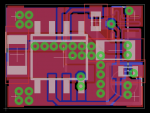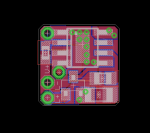rhd
0
- Joined
- Dec 7, 2010
- Messages
- 8,469
- Points
- 0
Re: OPEN Source: Tiny, high-current, boost driver (that doesn't work yet)
You've lost me - but that doesn't mean you're wrong!
Why not draw up the schematic?
Well, this is just a thought right now, but I'd put a 220K resistor in series with a 500K pot at pin 2 to ground. At the cathode of the schottkey diode I'd put two resistors and a pot in series to ground. First from the cathode would be 10K, then a 27K pot, then a 64K resistor to ground. The 10K resistor would be tied to pin 6 of the IC. You should be able to get 2.2volts to 6 volts out, at around 350mA to 900mA out. The LD would be tied to the cathode of the diode and ground. There would be a single cap to ground on the LD positive lead.
You've lost me - but that doesn't mean you're wrong!
Why not draw up the schematic?








